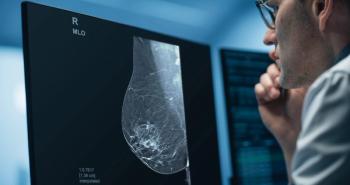
ACR Practice Guidelines Not Followed When Evaluating Nipple Discharge
Not following ACR practice guidelines potentially leads to unnecessary workups and extra health care costs.
There is significant variability among radiologists’ choice of imaging modality for evaluation of benign and pathologic nipple discharge, according to a study published in the
Researchers from Arizona and Georgia undertook an online survey to assess radiologists' choice of imaging modality for the evaluation of clinical symptoms of physiologic nipple discharge (e.g., bilateral discharge, multiple-duct orifices, and yellow, green, or white color) and pathologic nipple discharge (e.g., unilateral discharge, single-duct orifices, spontaneous and serous
A total of 8,170 surveys were sent to lead interpreting physicians at mammography facilities accredited by the American College of Radiology (ACR). The researchers received 849 responses, for a response rate of 10.4%. For the workup of physiologic nipple discharge, recommendations included:
- 30% screening mammography (SM)
- 24%, diagnostic mammography (DM) only
- 46%, both DM and targeted ultrasound (US) (DM plus US)
Practitioners in nonacademic settings and those who read breast images during less than 50% of their practice were significantly more likely to recommend DM (with or without US), compared with SM (the standard recommended by the ACR). Practitioners who read breast images less than 50% of the time were also more likely to recommend MRI after conventional imaging revealed negative results.
Related article:
For the workup of pathologic nipple discharge, recommendations included:
- 91.0% DM plus US
- 8.5%, DM only
- Fewer than 1.0%, SM
Nonacademic providers and those who read breast images less than 50% of the time were significantly less likely to recommend DM plus US (the standard recommended by the ACR), compared with DM only.
The researchers concluded that there is variability in imaging modality selection among U.S. radiologists handling the imaging workflow for benign and pathologic nipple discharge. Radiologists do not uniformly follow ACR practice guidelines, which potentially leads to unnecessary workups and extra healthcare costs.
Newsletter
Stay at the forefront of radiology with the Diagnostic Imaging newsletter, delivering the latest news, clinical insights, and imaging advancements for today’s radiologists.



























